Execute this notebook:
Download locally
Node classification with weighted Node2Vec¶
Introduction¶
This notebook illustrates how Node2Vec [1] can be applied to learn low dimensional node embeddings of an edge weighted graph through weighted biased random walks over the graph.
Specifically, the notebook demonstrates: 1. Learning node embeddings using Word2Vec algorithm applied to a set of weighted biased random walks performed over a graph. 2. Visualizing the node embeddings in 2-D using the t-SNE algorithm. 3. Demonstrating how the node embeddings calculated using Word2Vec can be used as feature vectors in a downstream task such as node classification. 4. Comparing node embeddings learnt from “unweighted Node2Vec” with “weighted Node2Vec” visually as well as in terms of accuracy of node classification task over the same underlying graph. 5. Lastly, performing a quick check of equivalency of weighted biased random walks to unweighted biased random walks when all edge weights are identically 1.
The example uses components from the stellargraph, Gensim, and scikit-learn libraries.
Note: For clarity of exposition, this notebook forgoes the use of standard machine learning practices such as Node2Vec parameter tuning, node feature standarization, data splitting that handles class imbalance, classifier selection, and classifier tuning to maximize predictive accuracy. We leave such improvements to the reader.
References¶
[1] Node2Vec: Scalable Feature Learning for Networks. A. Grover, J. Leskovec. ACM SIGKDD International Conference on Knowledge Discovery and Data Mining (KDD), 2016. (link)
[2] Distributed representations of words and phrases and their compositionality. T. Mikolov, I. Sutskever, K. Chen, G. S. Corrado, and J. Dean. In Advances in Neural Information Processing Systems (NIPS), pp. 3111-3119, 2013. (link)
[3] Gensim: Topic modelling for humans. (link)
[4] scikit-learn: Machine Learning in Python (link)
[3]:
from sklearn.manifold import TSNE
from sklearn.model_selection import train_test_split
from sklearn.linear_model import LogisticRegressionCV
from sklearn.metrics import accuracy_score
from sklearn.metrics.pairwise import pairwise_distances
from sklearn import preprocessing
import numpy as np
from stellargraph.data import BiasedRandomWalk
from stellargraph import StellarGraph
from gensim.models import Word2Vec
import warnings
import collections
from stellargraph import datasets
from IPython.display import display, HTML
import matplotlib.pyplot as plt
%matplotlib inline
Some global parameters¶
[4]:
walk_length = 100 # maximum length of a random walk to use throughout this notebook
Dataset¶
For weighted biased random walks the underlying graph should have weights over the edges. Since the links in the Cora dataset are unweighted, we need to synthetically add weights to the links in the graph. One possibility is to weight each edge by the similarity of its end nodes. Here we assign the Jaccard similarity of the features of the pair of nodes as the weight of edge which we can compute by logical operations on NumPy dataframes of the one-hot encoded features.
[5]:
def jaccard_weights(graph, _subjects, edges):
sources = graph.node_features(edges.source)
targets = graph.node_features(edges.target)
intersection = np.logical_and(sources, targets)
union = np.logical_or(sources, targets)
return intersection.sum(axis=1) / union.sum(axis=1)
(See the “Loading from Pandas” demo for details on how data can be loaded.)
[6]:
dataset = datasets.Cora()
display(HTML(dataset.description))
G, subjects = dataset.load(
largest_connected_component_only=True,
edge_weights=jaccard_weights,
str_node_ids=True, # Word2Vec requires strings, not ints
)
[7]:
print(G.info())
StellarGraph: Undirected multigraph
Nodes: 2485, Edges: 5209
Node types:
paper: [2485]
Features: float32 vector, length 1433
Edge types: paper-cites->paper
Edge types:
paper-cites->paper: [5209]
Just a quick look at the weights of the edges.
[8]:
_, weights = G.edges(include_edge_weight=True)
wt, cnt = np.unique(weights, return_counts=True)
plt.figure(figsize=(10, 8))
plt.bar(wt, cnt, width=0.005, color="b")
plt.title("Edge weights histogram")
plt.ylabel("Count")
plt.xlabel("edge weights")
plt.xticks(np.linspace(0, 1, 10))
plt.show()
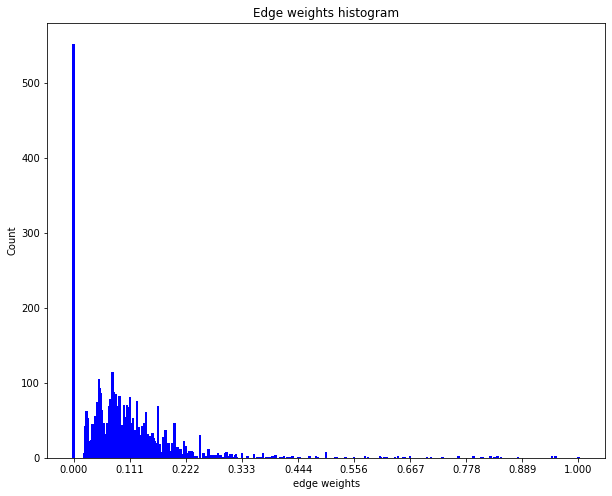
The above distribution of edge weights illustrates that majority of linked nodes are insignificantly similar in terms of their attributes.
The Node2Vec algorithm¶
The Node2Vec algorithm is a method for learning continuous feature representations for nodes in networks [1]. This approach can simply be described as a mapping of nodes to a low dimensional space of features that maximizes the likelihood of persevering neighborhood structure of the nodes. This approach is not tied to a fixed definition of neighborhood of a node but can be used in conjunction with different notions of node neighborhood, such as, homophily or structural equivalence, among other concepts. The algorithm efficiently explores diverse neighborhoods of nodes through a biased random walk procedure that is parametrized to emulate a specific concept of the neighborhood of a node.
Once a predefined number of walks, of fixed lengths, have been sampled, the low dimension embedding vectors of nodes can be learnt using Word2vec algorithm [2]. We use the Word2Vec implementation in the free Python library Gensim [3] to learn representations for each node in the graph.
Corpus generation using random walks¶
The stellargraph library provides an implementation of random walks that can be unweighted or weighted as required by Node2Vec. The random walks have a predefined fixed maximum length and are controlled by three parameters p, q, and weight. By default, the weight over the edges is assumed to be 1. See [1] for a detailed description of these parameters.
Weighted random walks¶
The first step for the weighted biased random walk is to build a random walk object by passing it a Stellargraph object.
[9]:
rw = BiasedRandomWalk(G)
The next step is to sample a set of random walks of predefined length starting from each node of the graph. Parameters p, q, and weighted influence the type of random walks in the procedure. In this demo, we are going to start 10 random walks from each node in the graph with a length up to 100. We set parameter p to 0.5 and q to 2.0 and the weight parameter set to True. The run method in the random walk will check if the weights over the edges are available and resolve
other issues, such as, whether the weights are numeric and that their is no ambiguity of edge traversal (i.e. each pair of node is connected by a unique numerically weighted edge).
[10]:
weighted_walks = rw.run(
nodes=G.nodes(), # root nodes
length=walk_length, # maximum length of a random walk
n=10, # number of random walks per root node
p=0.5, # Defines (unormalised) probability, 1/p, of returning to source node
q=2.0, # Defines (unormalised) probability, 1/q, for moving away from source node
weighted=True, # for weighted random walks
seed=42, # random seed fixed for reproducibility
)
print("Number of random walks: {}".format(len(weighted_walks)))
Number of random walks: 24850
Representation Learning using Word2Vec¶
Once we have a sample set of walks, we learn the low-dimensional embedding of nodes using Word2Vec approach. We set the dimensionality of the learned embedding vectors to 128 as in [1].
[11]:
weighted_model = Word2Vec(
weighted_walks, vector_size=128, window=5, min_count=0, sg=1, workers=1, epochs=1
)
[12]:
# The embedding vectors can be retrieved from model.wv using the node ID as key.
# E.g., for node id '19231', the embedding vector is retrieved as
emb = weighted_model.wv["19231"]
emb.shape
[12]:
(128,)
Visualise Node Embeddings generated by weighted random walks¶
We retrieve the Word2Vec node embeddings that are 128-dimensional vectors and then we project them down to 2 dimensions using the t-SNE algorithm for visualization.
[13]:
# Retrieve node embeddings and corresponding subjects
node_ids = weighted_model.wv.index_to_key # list of node IDs
weighted_node_embeddings = (
weighted_model.wv.vectors
) # numpy.ndarray of size number of nodes times embeddings dimensionality
# the gensim ordering may not match the StellarGraph one, so rearrange
node_targets = subjects.loc[node_ids].astype("category")
[14]:
# Apply t-SNE transformation on node embeddings
tsne = TSNE(n_components=2, random_state=42)
weighted_node_embeddings_2d = tsne.fit_transform(weighted_node_embeddings)
Plot the embeddings generated from weighted random walks¶
[15]:
# draw the points
alpha = 0.7
plt.figure(figsize=(10, 8))
plt.scatter(
weighted_node_embeddings_2d[:, 0],
weighted_node_embeddings_2d[:, 1],
c=node_targets.cat.codes,
cmap="jet",
alpha=0.7,
)
plt.show()
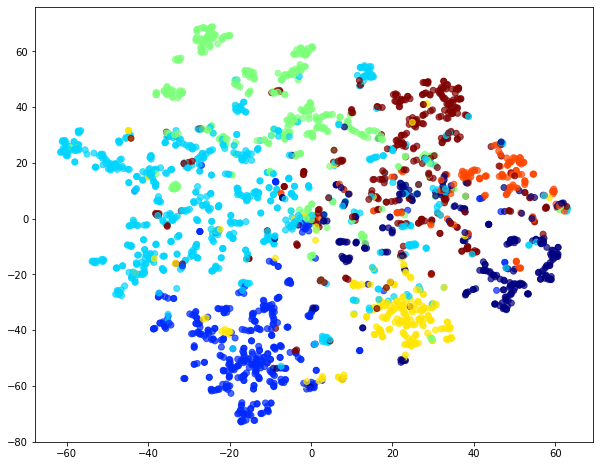
Downstream task¶
The node embeddings calculated using Word2Vec can be used as feature vectors in a downstream task such as node classification. Here we give an example of training a logistic regression classifier using the node embeddings, learnt above, as features.
[16]:
# X will hold the 128-dimensional input features
X = weighted_node_embeddings
# y holds the corresponding target values
y = np.array(node_targets)
Train and Test split¶
We use 75% of the data for training and the remaining 25% for testing as a hold out test set.
[17]:
X_train, X_test, y_train, y_test = train_test_split(
X, y, train_size=0.75, test_size=None, random_state=42
)
print(
"Array shapes:\n X_train = {}\n y_train = {}\n X_test = {}\n y_test = {}".format(
X_train.shape, y_train.shape, X_test.shape, y_test.shape
)
)
Array shapes:
X_train = (1863, 128)
y_train = (1863,)
X_test = (622, 128)
y_test = (622,)
Classifier Training¶
We train a Logistic Regression classifier on the training data.
[18]:
clf = LogisticRegressionCV(
Cs=10,
cv=10,
tol=0.001,
max_iter=1000,
scoring="accuracy",
verbose=False,
multi_class="ovr",
random_state=5434,
)
clf.fit(X_train, y_train)
[18]:
LogisticRegressionCV(Cs=10, class_weight=None, cv=10, dual=False,
fit_intercept=True, intercept_scaling=1.0, l1_ratios=None,
max_iter=1000, multi_class='ovr', n_jobs=None,
penalty='l2', random_state=5434, refit=True,
scoring='accuracy', solver='lbfgs', tol=0.001,
verbose=False)
Predict the hold out test set.
[19]:
y_pred = clf.predict(X_test)
Calculate the accuracy of the classifier on the test set.
[20]:
accuracy_score(y_test, y_pred)
[20]:
0.8263665594855305
Comparison to weighted and unweighted biased random walks¶
Lets compare weighted random walks with unweighted random walks. This simply requires toggling the weight parameter to False in the run method of the BiasedRandomWalk. Note, the weight parameter is by default set to False, hence, not specifying the weight parameter would result in the same action.
Step 1: performing unweighted walks¶
[21]:
walks = rw.run(
nodes=G.nodes(), # root nodes
length=walk_length, # maximum length of a random walk
n=10, # number of random walks per root node
p=0.5, # Defines (unormalised) probability, 1/p, of returning to source node
q=2.0, # Defines (unormalised) probability, 1/q, for moving away from source node
weighted=False, # since we are interested in unweighted walks
seed=42, # for reproducibility
)
print("Number of random walks: {}".format(len(walks)))
Number of random walks: 24850
Step 2: learning node embeddings¶
[22]:
model = Word2Vec(walks, vector_size=128, window=5, min_count=0, sg=1, workers=1, epochs=1)
Plot the embeddings generated from unweighted random walks.¶
[23]:
# Retrieve node embeddings and corresponding subjects
node_ids = model.wv.index_to_key # list of node IDs
node_embeddings = (
model.wv.vectors
) # numpy.ndarray of size number of nodes times embeddings dimensionality
node_targets = subjects.loc[node_ids].astype("category")
# Apply t-SNE transformation on node embeddings
tsne = TSNE(n_components=2, random_state=42)
node_embeddings_2d = tsne.fit_transform(node_embeddings)
# draw the points
alpha = 0.7
plt.figure(figsize=(10, 8))
plt.scatter(
node_embeddings_2d[:, 0],
node_embeddings_2d[:, 1],
c=node_targets.cat.codes,
cmap="jet",
alpha=0.7,
)
plt.show()
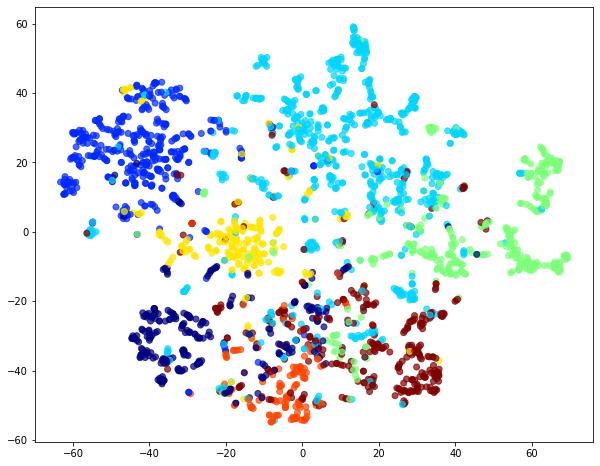
Visual comparison of node embedding plots for weighted and unweighted random walks illustrates the differences between the two.
Using unweighted random walks to train classifiers to predict the subject of a paper in Cora.¶
[24]:
# X will hold the 128-dimensional input features
X = node_embeddings
# y holds the corresponding target values
y = np.array(node_targets)
X_train, X_test, y_train, y_test = train_test_split(
X, y, train_size=0.75, test_size=None, random_state=42
)
print(
"Array shapes:\n X_train = {}\n y_train = {}\n X_test = {}\n y_test = {}".format(
X_train.shape, y_train.shape, X_test.shape, y_test.shape
)
)
Array shapes:
X_train = (1863, 128)
y_train = (1863,)
X_test = (622, 128)
y_test = (622,)
[25]:
clf = LogisticRegressionCV(
Cs=10,
cv=10,
tol=0.01,
max_iter=1000,
scoring="accuracy",
verbose=False,
multi_class="ovr",
random_state=5434,
)
clf.fit(X_train, y_train)
[25]:
LogisticRegressionCV(Cs=10, class_weight=None, cv=10, dual=False,
fit_intercept=True, intercept_scaling=1.0, l1_ratios=None,
max_iter=1000, multi_class='ovr', n_jobs=None,
penalty='l2', random_state=5434, refit=True,
scoring='accuracy', solver='lbfgs', tol=0.01,
verbose=False)
[26]:
y_pred = clf.predict(X_test)
[27]:
accuracy_score(y_test, y_pred)
[27]:
0.8247588424437299
Generally, the node embeddings extracted from unweighted random walks are more representative of the underlying community structure of the Cora dataset than the embeddings learnt from weighted random walks over the artificially weighted Cora network.
Testing whether weights = 1 gives identical result to unweighted random walks¶
Lastly, we perform a quick check of whether weighted biased random walks are identical to unweighted biased random walks when weights over the edges are identically 1.
First, set weights of all edges in the graph to 1.
[28]:
unweighted_G, _ = dataset.load(
largest_connected_component_only=True,
edge_weights=None,
str_node_ids=True, # Word2Vec requires strings, not ints
)
Quick check to confirm if all edge weights are actually 1.
[29]:
_, weights = unweighted_G.edges(include_edge_weight=True)
wt, cnt = np.unique(weights, return_counts=True)
plt.figure(figsize=(10, 8))
plt.bar(wt, cnt, width=0.005, color="b")
plt.title("Edge weights histogram")
plt.ylabel("Count")
plt.xlabel("edge weights")
plt.xticks(np.linspace(0, 1, 10))
plt.show()
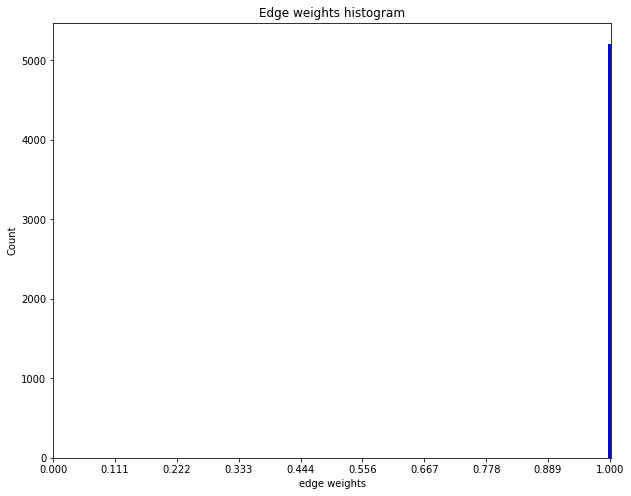
Step 1: create the biased random walk object¶
[30]:
rw = BiasedRandomWalk(unweighted_G)
Step 2: sample random walks from the graph.¶
[31]:
weighted_walks = rw.run(
nodes=unweighted_G.nodes(), # root nodes
length=walk_length, # maximum length of a random walk
n=10, # number of random walks per root node
p=0.5, # Defines (unormalised) probability, 1/p, of returning to source node
q=2.0, # Defines (unormalised) probability, 1/q, for moving away from source node
weighted=True, # indicates the walks are weighted
seed=42, # seed fixed for reproducibility
)
print("Number of random walks: {}".format(len(weighted_walks)))
Number of random walks: 24850
Compare unweighted walks with weighted walks when all weights are uniformly set to 1. Note, the two sets should be identical given all other parameters and random seeds are fixed.
[32]:
assert walks == weighted_walks
Step 3: learn node embeddings from the walks sampled above.¶
[33]:
weighted_model = Word2Vec(
weighted_walks, vector_size=128, window=5, min_count=0, sg=1, workers=1, epochs=1
)
Plot the embeddings in 2-D using t-SNE transformation for visual comparison to the embeddings learnt from unweighted walks.¶
[34]:
# Retrieve node embeddings and corresponding subjects
node_ids = weighted_model.wv.index_to_key # list of node IDs
weighted_node_embeddings = (
weighted_model.wv.vectors
) # numpy.ndarray of size number of nodes times embeddings dimensionality
# Apply t-SNE transformation on node embeddings
tsne = TSNE(n_components=2, random_state=42)
weighted_node_embeddings_2d = tsne.fit_transform(weighted_node_embeddings)
# draw the points
alpha = 0.7
plt.figure(figsize=(10, 8))
plt.scatter(
weighted_node_embeddings_2d[:, 0],
weighted_node_embeddings_2d[:, 1],
c=node_targets.cat.codes,
cmap="jet",
alpha=0.7,
)
plt.show()
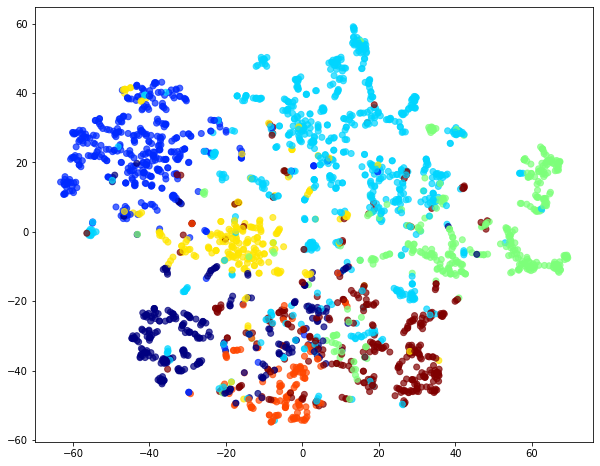
Comparing the accuracy of node classification for weighted (weight ==1) and unweighted random walks.¶
Compare classification of nodes through logistic regression on embeddings learnt from weighted (weight == 1) walks to that of unweighted walks demonstrated above.
[35]:
# X will hold the 128-dimensional input features
X = weighted_node_embeddings
# y holds the corresponding target values
y = np.array(node_targets)
X_train, X_test, y_train, y_test = train_test_split(
X, y, train_size=0.75, test_size=None, random_state=42
)
print(
"Array shapes:\n X_train = {}\n y_train = {}\n X_test = {}\n y_test = {}".format(
X_train.shape, y_train.shape, X_test.shape, y_test.shape
)
)
Array shapes:
X_train = (1863, 128)
y_train = (1863,)
X_test = (622, 128)
y_test = (622,)
[36]:
clf = LogisticRegressionCV(
Cs=10,
cv=10,
tol=0.001,
max_iter=1000,
scoring="accuracy",
verbose=False,
multi_class="ovr",
random_state=5434,
)
clf.fit(X_train, y_train)
[36]:
LogisticRegressionCV(Cs=10, class_weight=None, cv=10, dual=False,
fit_intercept=True, intercept_scaling=1.0, l1_ratios=None,
max_iter=1000, multi_class='ovr', n_jobs=None,
penalty='l2', random_state=5434, refit=True,
scoring='accuracy', solver='lbfgs', tol=0.001,
verbose=False)
[37]:
y_pred = clf.predict(X_test)
[38]:
accuracy_score(y_test, y_pred)
[38]:
0.8247588424437299
[39]:
np.array_equal(weighted_node_embeddings, node_embeddings)
[39]:
True
The weighted random walks with weight == 1 are identical to unweighted random walks. Moreover, the embeddings learnt over the two kinds of walks are identical as well.
Conclusion:¶
The above demo of application of Node2Vec method on the CORA dataset using weighted biased random walks demonstrates, weighted biased random walks produce inherently different node embeddings from the embeddings learnt through unweighted random walks over the same graph, as illustrated by t-SNE visualization of the two as well as comparison of performance over node classification. These differences illustrate that (realistic) weights on the edges of a graph can be leveraged to learn more accurate representation of nodes in low dimensional feature space.
Execute this notebook:
Download locally
